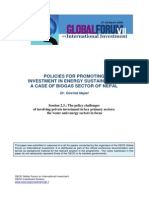Access To Rural Energy
Access To Rural Energy
Uploaded by
Krish DahCopyright:
Available Formats
Access To Rural Energy
Access To Rural Energy
Uploaded by
Krish DahOriginal Description:
Original Title
Copyright
Available Formats
Share this document
Did you find this document useful?
Is this content inappropriate?
Copyright:
Available Formats
Access To Rural Energy
Access To Rural Energy
Uploaded by
Krish DahCopyright:
Available Formats
December 2002 Number 191
ACCESS TO ENERGY IN DEVELOPING COUNTRIES
Increasing access to energy in developing countries has proved to be a challenging and contentious issue within the international development community. Agencies are now realising the limitations of past energy-related interventions and undertaking a widespread review of policy in this area. In the UK, the Department for International Development (DFID) is currently embarking on a new approach. This briefing outlines the current scale of energy needs in developing countries, the issues associated with meeting these needs and the role of the UK in adopting a new perspective. Energy provides services to meet many basic human needs, particularly heat, motive power (e.g. water pumps and transport) and light. Business, industry, commerce and public services such as modern healthcare, education and communication are highly dependent on access to energy services. Indeed, there is a direct relationship between the absence of adequate energy services and many poverty indicators such as infant mortality, illiteracy, life expectancy and total fertility rate.1 Inadequate access to energy also exacerbates rapid urbanisation in developing countries, by driving people to seek better living conditions. Around 1.6 billion people in developing countries lack access to adequate energy services. 80% live in rural areas, predominantly in sub-Saharan Africa and South Asia. The table opposite illustrates the disparities in global energy consumption, where developed countries consume around six times as much energy per person as developing countries. Increasing energy consumption has long been tied directly to economic growth and improvement in human welfare. However it is unclear whether increasing energy consumption is a necessary precondition for economic
OECD countries Developing countries 173 27 181 29 194 34
Energy use in the developed and developing worlds1 region primary energy use (gigajoules/person) 1985 1990 1997
growth, or vice versa. Although developed countries are now beginning to decouple their energy consumption from economic growth (through structural changes and increases in energy efficiency), there remains a strong direct relationship between energy consumption and economic development in developing countries. Sources of energy in developing countries Around half of all people in developing countries are dependent for fuel on wood, dung and crop residue, collectively known as traditional biomass. Three quarters of these live in China, India and sub-Saharan Africa. The International Energy Agency (IEA) has forecast that use of traditional biomass will decrease in many countries, but is likely to increase in South Asia and sub-Saharan Africa alongside population growth. Overall, the IEA forecasts that by 2030, the total number of people reliant on biomass will not have changed significantly. While the use of traditional energy sources is not necessarily undesirable in itself, concerns have been raised over how they are currently being used. The box on the next page outlines the major questions about the current use of many traditional fuels. Modern energy sources, such as electricity and petroleum-based fuels, generally provide only a small part of the energy use of poor rural people. This is mainly because they are too expensive and because it can prove difficult to achieve regular supplies to isolated rural communities.
Energy and development
postnote December 2002 Number 191 Access to energy in developing countries Page 2
Efficiency - current utilisation practices tend to have low efficiencies (~10%) Economic burden and gender disparities - time spent on collecting and using traditional fuels represents a significant burden, mainly for women - time that could be spent on productive tasks and education. Environment - use of fuelwood for energy can exacerbate deforestation, which often has knock-on effects such as loss of wildlife, soil erosion and increased flooding. Health - cooking on traditional stoves is a major source of concentrated air pollutants, including respirable particulate matter (in smoke) and gases such as carbon monoxide and nitrogen oxides. According to the World Health Organisation (WHO), long-term exposure to smoke can increase the risk of a child developing acute respiratory infection by between 2 and 4 times. The WHO estimates that 2.5 million women and young children in developing countries die prematurely each year as a result of breathing the fumes from indoor biomass stoves.
Concerns over traditional biomass fuels
Options for energy supply in developing countries
Projections of global primary energy demand to 2050 (Gigatonnes of oil equivalent) 2050 1990 High Middle Ecologically growth course driven
OECD Economies in Transition Developing Countries World Total 4.2 1.7 3.1 9.0 6.7 3.7 14.4 24.8 5.6 2.4 11.8 19.8 3.0 1.7 9.5 14.2
Electricity grid extensions while clean and efficient at the point of use, extending electricity grids is capital intensive and requires on-going maintenance Small scale hydropower systems these tend to have high capital costs but relatively low maintenance costs, a long service life, high operational reliability (given water availability) and low environmental impact Solar energy systems (photovoltaic and solar thermal) these have few environmental impacts, but initial costs can be high. Maintenance and replacement may be difficult in isolated communities. Small scale wind energy systems these tend to have high capital costs but low running costs. Supply is intermittent and so energy storage is necessary for reliability Biogas and liquid biofuels (alcohols and vegetable oils) these tend to have low capital costs and beneficial byproducts Improved biomass this is focused on enhancing the use of biomass through technologies such as improved cooking stoves, aimed at increasing efficiency and reducing air pollution. Hybrid systems these provide a mix of energy sources for electricity generation and can frequently reduce costs, and ensure a reliable supply (e.g. wind and grid extensions).
Source: World Energy Council
Energy forecasts in developing countries As their economies develop over the next few decades, the demand for energy services in developing countries is expected to increase considerably, especially in rural areas. As well as meeting household needs for an adequate supply of energy, there is growing demand for rural services such as water supply, sanitation, health care and education, and for productive activities such as agriculture and small industries. In 2000, the World Energy Council2 (WEC) published updated long term projections for global energy demand for three scenarios up to the year 2050: high economic growth; ecologically driven growth; and a middlecourse scenario. As is evident from the table above, even under the least energy intensive ecologically driven scenario, primary energy demand in developing countries is expected to triple and form up to two thirds of total global demand by 2050.
end uses desired in each locality, as not all technologies are adaptable and cost effective for particular end uses. However, technology is not the only consideration, and other factors include: the impact on those whose livelihoods depend on the processing and sale of traditional fuels local preferences, attitudes and perceptions knock-on benefits, such as the creation of jobs associated with supporting industries.
Issues
The effectiveness of international aid The box on the next page outlines the key features of energy-related aid in the last 20 years. There is now a growing consensus among international development agencies that many of these attempts have not been entirely successful and that a new perspective is needed. This has resulted in a widespread review of policy by multilateral and bilateral agencies alike. Energy financing The availability of adequate finance is one of the main challenges in meeting current and future demand for energy in developing countries. Current energy investments total US$290-430 billion per year and the WEC has estimated that a total of US$30 trillion over thirty years will be required to meet a 70% increase in global energy demand. The WECs scenarios suggest growth in total world energy demand of between 58% and 175% by 2050 (see box above). Current sources of energy finance in developing countries include governments, multilateral institutions, private investors (local and international) and overseas development assistance (ODA). Given the scale of the challenge, it has been generally acknowledged that the public sector in many developing countries will not be able to finance all the investment needed to satisfy
Options for delivering energy
Meeting energy demand in developing countries thus presents a significant challenge. The box opposite outlines a number of the technological options available to provide the energy required. The optimum choice of technology will be specific to each location and depends on a number of factors including resource availability, affordability, ease of access and local capacity to absorb, use and maintain the technology. It will also depend on the services and
postnote December 2002 Number 191 Access to energy in developing countries Page 3
growing energy demand requirements. Increasingly, the task of ensuring adequate energy supplies is seen as one for the private sector. Here, key drivers have included structural adjustment and energy sector reform programmes, central to which has been the privatisation of publicly owned utilities and the removal of subsidies. Despite the involvement of the private sector in such programmes, recent international energy reports have pointed out that securing the amount of investment required has proved to be difficult. The WEC suggests that this is due to a combination of barriers, including unfavourable conditions faced by private and foreign investors in many developing countries (particularly corruption and fragile governments) coupled with the fairly low rates of return associated with typical energy investments. Furthermore, the World Bank points out that although energy investment increased almost 4-fold in the early 1990s, it later declined significantly as a result of a global financial downturn in 1997. This has led development organisations to press for policies to encourage private investment, and the setting up of institutional structures such as local co-operatives, which would work to improve local energy provision in rural areas. Affordability Where modern energy services exist, a major barrier still remaining is affordability. In India for instance, although electricity networks are technically within reach of 90% of the population, only 43% are actually connected, as many remain unable to afford the cost of connection. Where extension of electricity networks is not viable (in remote rural areas), many of the technologies that are best suited to provide energy services to those areas (e.g. solar or wind energy), have high initial capital costs as well as maintenance and replacement costs. One approach to financing is to pay subsidies to those on low incomes. Many developing country governments actively promote this approach to replace traditional biomass with modern energy sources, particularly electricity. However, evidence points to subsidised energy services being diverted to unintended uses and disproportionately benefiting those otherwise able to afford the true market costs of supply (such as commercial businesses and the more affluent). Alternative approaches to financing have recently emerged focusing on improved access to micro-credit and lending to purchase energy supply technologies and energy services. Evidence has shown that poor people in developing countries are willing to pay for energy services if they are able to do so. This has led the United Nations Development Program (UNDP) to suggest that poor rural households represent a large potential market. Here, UNDP argues, the private sector and banking institutions can play a role by providing micro-credit financing.
Key features of international aid efforts to date
Large scale power generation projects Much of the early international aid interventions were carried out through the development of large-scale energy projects (mostly hydropower), often led by commercial interests. Although these proved to be effective in providing energy to large numbers of people, widespread criticism of their consequences (including displacement of people and undesirable environmental effects); as well as their focus on providing energy for urban centres led to a substantial decrease in their numbers. Rural electrification: Most interventions aimed at increasing energy services in rural areas have focused on grid extensions and distribution of electricity from large-scale generation facilities. Experience has revealed that successful electrification depends on: the ability to recognise that some areas are more viably served through locally generated (decentralised) electricity (such as when grid extension costs are too high or demand is intermittent) the availability and affordability of the conversion technologies and electrical appliances needed the presence of complementary social and economic infrastructure such as microcredit lending schemes, rural water supply, healthcare and schools. Power sector reform In the 1990s, energy related development aid projects were replaced by efforts aimed at reforming the energy sector in developing countries, primarily existing electricity and gas networks. According to the World Bank, limited study on their effectiveness reveals that despite financial and institutional innovations in providing energy to low income areas, the reforms have made little impact on improving energy services to the poor. The World Summit on Sustainable Development (WSSD) Energy was identified as one of the five thematic areas to be covered in advance of WSSD (along with water, health, agriculture and biodiversity) and featured strongly in the Draft Plan of Implementation. Although several specific targets for action were proposed, these were not adopted by the international community and WSSD achieved very little in this area. Improved biomass A considerable amount of development aid has been targeted towards improving the current use of biomass, based on the adaptation of traditional stoves to increase efficiency and limit adverse effects (as illustrated in the box on page 2). Development organisations such as the Intermediate Technology Development Group regard such efforts as being largely successful.
Technology barriers Although various energy technologies are available in the global market, they remain beyond the reach of many developing countries. Recognising this, many in the development community have called for increased efforts to transfer these technologies from the developed to the developing world. However, simply having access to the technology will not guarantee that people in need will receive the energy services. It is also necessary to ensure that there is adequate capacity in developing countries for suitable people to obtain and enhance technological skills and capability to acquire, select and absorb that knowledge into local settings. Hence many agree that technology transfer and capacity building must come hand in hand.
postnote December 2002 Number 191 Access to energy in developing countries Page 4
It is widely known that the proliferation of new technologies to developing countries is constrained by an unwillingness of some technology owners to transfer their intellectual property (e.g. through unfavourable terms in patents and licensing agreements). This arises primarily where intellectual property holders perceive an absence of adequate regulations within developing countries to ensure the protection of their property rights. In this context, the Department of Trade and Industry (DTI) is leading the UKs efforts to begin a new round of negotiations under the World Trade Organisation. The question remains whether the new round will tackle how international property rights might affect development. The UK role Technological transfer and capacity building The UK is currently involved in a number of initiatives and partnerships that involve the transfer of energy technologies and knowledge to developing countries (see box opposite). However, there is no oversight of the range of initiatives. Indeed, many are aimed primarily at promoting and aiding UK business in exporting new and innovative technologies, while development objectives appear secondary to this. Thus, some have called for closer coordination between these initiatives and a clear statement of their goals, ensuring that the development agenda is taken fully into account. Private Sector Engagement The UK is also taking steps to facilitate energy investments by the private sector through the Export Credit Guarantee Department (ECGD) of the Department of Trade and Industry (DTI). The ECGD aims to provide guarantees, insurance and reinsurance against loss for exporters of UK goods to developing countries. The Government has recently announced that beginning in April 2003, the ECGD will aim to provide developing countries with improved access to renewable energy technologies by making at least 50 million worth of credit guarantees available each year for exports in the sector. ECGD will also be working with DTI, Trade Partners UKs Export Promoters and Renewable UK to help them identify opportunities for exporters and investors in the renewables sector. Furthermore, the Kyoto Protocols Clean Development Mechanism3 provides an opportunity for UK business to transfer efficient, clean and appropriate energy technologies to developing countries, while contributing towards UK greenhouse gas reduction targets. However, although interest has been expressed by larger multinational organisations, CDM projects may be unattractive due to high transaction costs. DTI has recently set up a Climate Change Projects Office, to provide advice and support to UK business in pursuing these types of projects. DFID has also recently commissioned research aimed at facilitating investments in small, rural, poverty focused projects. A new approach to energy related development aid The limitations of previous development assistance aimed at increasing energy access have been widely
New and Renewable Energy Programme - encourages the commercialisation of renewable energy technologies and other novel energy sources. A major part of the programme is devoted to technology transfer and export promotion. Technology Partnership Initiative (TPI) - encourages the transfer of environmental technologies, mainly by providing access to information about UK suppliers. (500K per year) Commonwealth Partnership for Technology Management (CPTM) - partnerships between governments of British Commonwealth countries and the private sector, established as part of the UK Governments aim to encourage the formation of global technology transfer networks and partnerships. (60K per year) Asia-Europe Environmental Technology Centre (AEETC) aims to encourage partnership between EU and Asian organisations in the transfer of environmental technology and R&D activities. (80K per year) Centre for the Analysis and Dissemination of Demonstrated Energy Technologies (CADDET) aims to provide information on proven technologies to help accelerate their adoption in the market both nationally and internationally Hands on Training Scheme (HOTS) geared towards helping companies establish overseas contacts by helping business meet the cost of a short-term training in the UK for individuals or groups to learn about sector specific technology or practice. (120K per year) Centres of Excellence for Technology Innovation for Sustainability in Africa (CETISA). The Royal Institute of International Affairs, with support from the UK government launched this Type 2 partnership at WSSD. The initiative is bringing together partners from governments in Africa and other countries, along with intergovernmental organisations, businesses and civil society groups to design and establish a network of centres of excellence. The partnership aims to build science and technology capacity to enable the development and implementation of the technological solutions needed for sustainable development.
UK technology transfer programs
acknowledged among development agencies. In 2002 DFID published an issues paper outlining a new approach to energy assistance4. This addresses many of the issues highlighted above, including: developing local capacity; attracting private investment in energy services and providing access to finance and reducing costs. The question remains as to how this new strategy for energy assistance will be implemented.
Endnotes 1 International Energy Agency: World Energy Outlook 2000. 2 The World Energy Council (WEC) is a UN- accredited, non governmental organisation renowned for its research and analysis of energy issues on a global level. It is a UK based charity. (www.worldenergy.org) 3 For further information on the Clean Development Mechanism, see POSTnote 176 Ratifying Kyoto. 4 Available at: envpov.aeat.com/ENPOV/
POST is an office of both Houses of Parliament, charged with providing independent and balanced analysis of public policy issues that have a basis in science and technology. POST is grateful to Roon Osman and Imperial College for Energy Policy and Technology for the research undertaken in the preparation of this briefing note. A longer report is available on the POST website. Parliamentary Copyright 2002 The Parliamentary Office of Science and Technology, 7 Millbank, London SW1P 3JA Tel 020 7219 2840
www.parliament.uk/post/home.htm
You might also like
- DragonDocument10 pagesDragonCristina Amariutei100% (7)
- ESCAP HLiu Financing Renewable Energy 270313Document7 pagesESCAP HLiu Financing Renewable Energy 270313sanjay_kafleNo ratings yet
- A Place For Energy Poverty in The AgendaDocument6 pagesA Place For Energy Poverty in The AgendaOsmar RGNo ratings yet
- Twin Peaks: Surmounting The Global Challenges of Energy For All and Greener, More Efficient Electricity ServicesDocument10 pagesTwin Peaks: Surmounting The Global Challenges of Energy For All and Greener, More Efficient Electricity ServicesnguyenductuyenNo ratings yet
- Energy For Sustainable Development Business Recommendations and RolesDocument9 pagesEnergy For Sustainable Development Business Recommendations and RolesSuvro MukherjeeNo ratings yet
- Energy Scoping Paper 2007-02-06Document17 pagesEnergy Scoping Paper 2007-02-06zafar_iqbal_36No ratings yet
- Hoi Why Kong-WordDocument15 pagesHoi Why Kong-WordAtikah Abu BakarNo ratings yet
- Renewable Energy Global ChallengesDocument9 pagesRenewable Energy Global ChallengesDanylo NosovNo ratings yet
- UN-DESA Policy Brief No. 24: Climate Change and The Energy ChallengeDocument2 pagesUN-DESA Policy Brief No. 24: Climate Change and The Energy ChallengendaatlantaNo ratings yet
- Iii - Energy and Climate Global Energy Demand and Supply-Present and FutureDocument5 pagesIii - Energy and Climate Global Energy Demand and Supply-Present and Futureandrei CalloNo ratings yet
- WBCSD FinanceDocument15 pagesWBCSD FinancebalambalamNo ratings yet
- Policies For Promoting Investment in Energy Sustainability A Case of Biogas Sector of NepalDocument20 pagesPolicies For Promoting Investment in Energy Sustainability A Case of Biogas Sector of NepalhamaeumNo ratings yet
- Anurag Atre 1Document34 pagesAnurag Atre 1Kshitij TareNo ratings yet
- Sustainability For Developing CountriesDocument4 pagesSustainability For Developing CountriesDavid Halomoan MalauNo ratings yet
- 1111 268 Coal - Energy For Sustainable Development Final (16!04!2012)Document40 pages1111 268 Coal - Energy For Sustainable Development Final (16!04!2012)Anonymous kTVBUxr100% (1)
- ECOSOC TOPIC A: "Overcoming Energy Poverty in Developing Countries"Document13 pagesECOSOC TOPIC A: "Overcoming Energy Poverty in Developing Countries"ammaraharifNo ratings yet
- North South DebateDocument16 pagesNorth South DebateGaurav AglechaNo ratings yet
- Coal - Energy For Sustainable Development Final (16!04!2012)Document40 pagesCoal - Energy For Sustainable Development Final (16!04!2012)Rachel DaughertyNo ratings yet
- Wind Energy Industry in The US and Canada A Note On The Regulatory EnvironmentDocument9 pagesWind Energy Industry in The US and Canada A Note On The Regulatory Environmentrakeshb11No ratings yet
- 06185747Document5 pages06185747nguyenductuyenNo ratings yet
- 1.2 Energy and Sustainable Development: 2 Principles of Renewable EnergyDocument3 pages1.2 Energy and Sustainable Development: 2 Principles of Renewable EnergyRaisa D. Carmen Trujillo RivasNo ratings yet
- Rem201 - Renewable Energy Systems (A) Module Assignment Answer - Question 1Document7 pagesRem201 - Renewable Energy Systems (A) Module Assignment Answer - Question 1Paul OgleNo ratings yet
- Poverty, Energy and Society: Human Development Report 1997 Put Forth A Definition of "Human Poverty" That SeesDocument13 pagesPoverty, Energy and Society: Human Development Report 1997 Put Forth A Definition of "Human Poverty" That SeesNguyen Khanh ChanNo ratings yet
- DURVA SHETYE - International Oil Companies Betting On Renewables - A Right StrategyDocument4 pagesDURVA SHETYE - International Oil Companies Betting On Renewables - A Right StrategyDurva ShetyeNo ratings yet
- Climate Action - Achieving Green and Inclusive GrowthDocument18 pagesClimate Action - Achieving Green and Inclusive GrowthKirit NaikNo ratings yet
- Renewable EnergyDocument22 pagesRenewable EnergyRaju Sk100% (1)
- The Future of Renewable Energy and Its Global ImpactDocument1 pageThe Future of Renewable Energy and Its Global ImpactKemale ZamanliNo ratings yet
- Trends in Household Energy ConsumptionDocument21 pagesTrends in Household Energy ConsumptionSiddhartha KoduruNo ratings yet
- Renewable Energy For Sustainable Development Goal of Clean 2xwmb24pDocument15 pagesRenewable Energy For Sustainable Development Goal of Clean 2xwmb24pHIMA GUPTANo ratings yet
- Waste-to-Energy Solution Technology For Next GenerationDocument3 pagesWaste-to-Energy Solution Technology For Next GenerationEditor IJIRMFNo ratings yet
- IIED, Global Goal On Energy Access, Briefing, 11-2013Document4 pagesIIED, Global Goal On Energy Access, Briefing, 11-2013Detlef LoyNo ratings yet
- Development Needs Sustainable Energy: BMZ Topics 187Document43 pagesDevelopment Needs Sustainable Energy: BMZ Topics 187Taha HashmiNo ratings yet
- Reforming Energy SubsidiesDocument34 pagesReforming Energy SubsidiesM Bilal MehboobNo ratings yet
- Power FailureDocument20 pagesPower FailureEmil KledenNo ratings yet
- Lewis' Thesis ProposalDocument10 pagesLewis' Thesis ProposalLewis BlagogieNo ratings yet
- Energy Poverty - The Hidden CrisisDocument8 pagesEnergy Poverty - The Hidden CrisisDetlef LoyNo ratings yet
- Solar Power Concept PaperDocument7 pagesSolar Power Concept Paperrasnowmah2012No ratings yet
- Managerial Economics Final ProjectDocument4 pagesManagerial Economics Final ProjectjohnNo ratings yet
- Energy Systems 2Document13 pagesEnergy Systems 2Sudesh Fernando Vayanga SubasinghaNo ratings yet
- Sustainable Energy For All: UN Effort To Advance Human Progress in Harmony With NatureDocument4 pagesSustainable Energy For All: UN Effort To Advance Human Progress in Harmony With NatureMuhammad Rizki FebriantoNo ratings yet
- Energies: Factors Influencing The Renewable Energy Consumption in Selected European CountriesDocument27 pagesEnergies: Factors Influencing The Renewable Energy Consumption in Selected European CountriesDuong LeNo ratings yet
- McKinsey Global Institute Report On Promoting Energy Efficiency in The Developing WorldDocument5 pagesMcKinsey Global Institute Report On Promoting Energy Efficiency in The Developing WorldankurtulsNo ratings yet
- 8 - Efficient Use of EnergyDocument6 pages8 - Efficient Use of Energyfreddy2104No ratings yet
- Meier and Rauch - 10.1 and 10.5Document7 pagesMeier and Rauch - 10.1 and 10.5Prasansha LodhiNo ratings yet
- On Energy ConservationDocument21 pagesOn Energy ConservationGajendra TeliNo ratings yet
- POWER SECTOR Industry AnalyticsDocument74 pagesPOWER SECTOR Industry AnalyticsKanchan RaiNo ratings yet
- An Overview of The Injustice Compressed 1Document10 pagesAn Overview of The Injustice Compressed 1api-541981758No ratings yet
- Application of BiomassDocument165 pagesApplication of BiomassTiago HenriquesNo ratings yet
- Energy Genaration PDFDocument22 pagesEnergy Genaration PDFMahesh KumarNo ratings yet
- Reforming Energy SubsidiesDocument33 pagesReforming Energy SubsidiesPedro CangoNo ratings yet
- Solar Power As A Sustainable Source of Electricity For The Future GenerationDocument10 pagesSolar Power As A Sustainable Source of Electricity For The Future Generationedumarshall01No ratings yet
- UntitledDocument43 pagesUntitledNouh Al-SayyedNo ratings yet
- SSRN Id2799150Document18 pagesSSRN Id2799150Surabhi ChaturvediNo ratings yet
- Moteng Et Al. (2023) - Intenational - Sanction - and - Energy - PovertyDocument24 pagesMoteng Et Al. (2023) - Intenational - Sanction - and - Energy - PovertyTotouom ArmandNo ratings yet
- Household Cooking Fuel Choice and Adoption of Improved Cookstoves in Developing CountriesDocument52 pagesHousehold Cooking Fuel Choice and Adoption of Improved Cookstoves in Developing CountriessusanswaNo ratings yet
- United Nations: II. Fossil Fuels: The Continuing DilemmaDocument1 pageUnited Nations: II. Fossil Fuels: The Continuing DilemmacobalamyanineNo ratings yet
- Energy Consumption PatternDocument6 pagesEnergy Consumption Patternchem_muruNo ratings yet
- Statistical Issues Bioenergy and Distributed Renewable EnergyDocument18 pagesStatistical Issues Bioenergy and Distributed Renewable EnergyRubenCCNo ratings yet
- Transforming the energy systemFrom EverandTransforming the energy systemNo ratings yet
- ViatorCheck PDFDocument23 pagesViatorCheck PDFazitaggNo ratings yet
- Wepik Revolutionizing Road Infrastructure A Comprehensive Overview of Road Civil Engineering 20231029040210dc0iDocument10 pagesWepik Revolutionizing Road Infrastructure A Comprehensive Overview of Road Civil Engineering 20231029040210dc0isameerkant089No ratings yet
- Six Months Industrial Training SWARAJDocument44 pagesSix Months Industrial Training SWARAJSingh KarandeepNo ratings yet
- ICSE - Geog - India Location, Extent, Political - 1Document13 pagesICSE - Geog - India Location, Extent, Political - 1Tara bhai JoginderNo ratings yet
- Backyard BiologistDocument2 pagesBackyard Biologistapi-234287636No ratings yet
- CustomersDocument109 pagesCustomersOmar NoahNo ratings yet
- (With Price) : Electronic KeyboardDocument30 pages(With Price) : Electronic KeyboardMauricioCostadeCarvalhoNo ratings yet
- SAP Netweaver GatewayDocument16 pagesSAP Netweaver GatewayVictor UribeNo ratings yet
- Determining The Scope of The Quality Management SystemDocument6 pagesDetermining The Scope of The Quality Management SystemNaeemNo ratings yet
- Permutations and Combinations: (IIT JEE - 1985 - 5 Marks)Document2 pagesPermutations and Combinations: (IIT JEE - 1985 - 5 Marks)Vatsal PatelNo ratings yet
- Business PlanDocument36 pagesBusiness PlanArun NarayananNo ratings yet
- EXAMEN PARCIAL N°2 CUESTIONARIO - Revisión Del Intento FinalDocument6 pagesEXAMEN PARCIAL N°2 CUESTIONARIO - Revisión Del Intento FinalcladavidNo ratings yet
- ITEC-425 / SENG-425: Python Programming Lab Lab 6: Working With Files I/ODocument3 pagesITEC-425 / SENG-425: Python Programming Lab Lab 6: Working With Files I/OUmm E Farwa KhanNo ratings yet
- Sterner Infranor 872 & 876 Series Brochure 2005Document6 pagesSterner Infranor 872 & 876 Series Brochure 2005Alan MastersNo ratings yet
- 4 EAGLE 2024 Prents Permit Activity RosterDocument3 pages4 EAGLE 2024 Prents Permit Activity RosterRichard SluderNo ratings yet
- Technical Specification For The Purchase of 1 Unit of 240HP Crawler TractorDocument14 pagesTechnical Specification For The Purchase of 1 Unit of 240HP Crawler TractoragegnehutamiratNo ratings yet
- REOTEMP INSTRUMENTS Product Drawing Thermowell, (Limited Space) With: - Threaded Process Connection - Straight ShankDocument1 pageREOTEMP INSTRUMENTS Product Drawing Thermowell, (Limited Space) With: - Threaded Process Connection - Straight ShankInsertec LtdaNo ratings yet
- THESISDocument24 pagesTHESISWilson TanNo ratings yet
- x50 M3u Links Tested Fnx20Document32 pagesx50 M3u Links Tested Fnx20Maverick ChukwuNo ratings yet
- Datasheet PDFDocument7 pagesDatasheet PDFNilton sergio gomes linsNo ratings yet
- Amul Distribution SIP ReportDocument31 pagesAmul Distribution SIP ReportAbhishek DeshpandeNo ratings yet
- Ratio Analysis of Asia Pacific General Insurance Company Limited.Document18 pagesRatio Analysis of Asia Pacific General Insurance Company Limited.Harunur RashidNo ratings yet
- 1st Prelim EconDocument3 pages1st Prelim Econmharjun lampaNo ratings yet
- 2 - MODUL Audience Analysis - 14 Mhs PDFDocument17 pages2 - MODUL Audience Analysis - 14 Mhs PDFJessille silvNo ratings yet
- Physics Experiment Report (Iv) Basic Physics "Oscillation Mathematics"Document8 pagesPhysics Experiment Report (Iv) Basic Physics "Oscillation Mathematics"JkanthNo ratings yet
- Ste Micro ProjectDocument13 pagesSte Micro Projectethicalninja7No ratings yet
- Trek Volunteer Info Packet 2015Document6 pagesTrek Volunteer Info Packet 2015api-275865446No ratings yet
- A SWOT Analysis To Improve The Marketing of Young Coconut ChipsDocument10 pagesA SWOT Analysis To Improve The Marketing of Young Coconut ChipsPRO TradesmanNo ratings yet
- Lceture 1 Course InformationDocument21 pagesLceture 1 Course InformationBakyt SmagulovaNo ratings yet

























































































